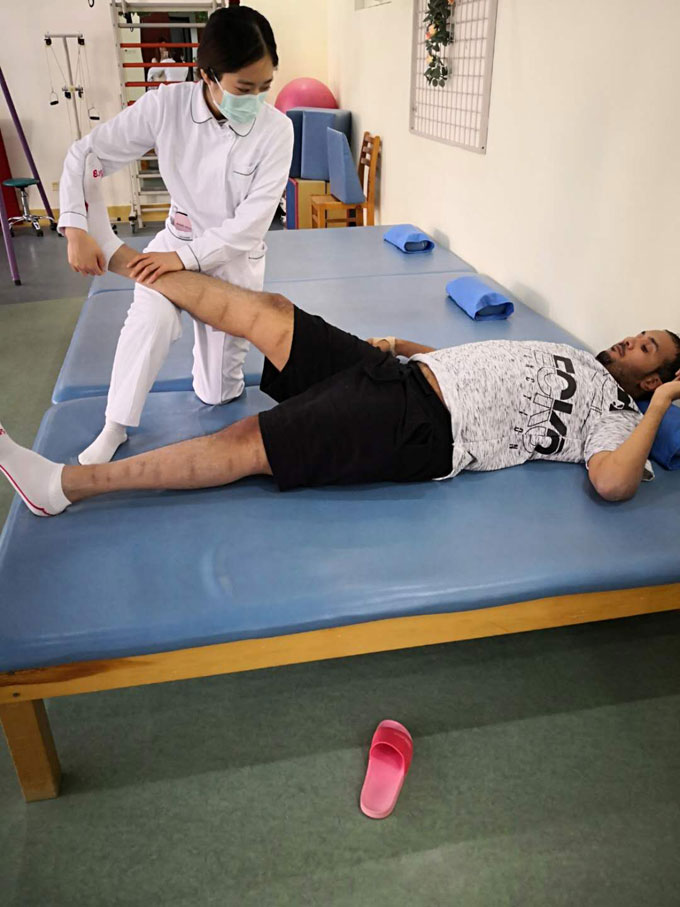Luai Hemeiadah-Multiple Sclerosis-(Saudi Arabia)
Before treatment: Admission PE: Nervous System Examination: Treatment: Post-treatment: Name: Luai Hemeiadah
Name: Luai Hemeiadah
Sex: Male
Nationality: Saudi Arabian
Age: 36Y
Diagnosis: Multiple Sclerosis
Eleven years ago the patient had no obvious inducement of arm numbness and poor urination control. He was treated in a local hospital and diagnosed as having "multiple sclerosis" by physical examination, blood examination and head and neck MRI examination. Doctors gave "oxybutynin" to control urination and also "interferon" treatment. After that the symptoms slightly alleviated and he then received twice weekly "interferon" intramuscular injection treatments. Eight years ago the tremor of the right arm began and then developed in the left arm. The patient was treated again. The doctor gave doses of cortisone treatment and the patient's symptoms were slightly alleviated. Six years ago his balance function was affected and this was accompanied by memory loss. His left lower extremity muscle strength reduced six months ago and the doctor gave him a "Rituximab" intramuscular injection every 6 months. However, the symptoms did not improve significantly and he stopped using "interferon" 2 years ago and took "fengomod" orally once a day. At present it is difficult for him to walk and the fine movement of his hands, drinking of water and eating are all affected.
Since the onset of the disease he has maintained a good spirit, normal appetite, irregular sleep, constipation, defecation every 3 or 4 days, poor urination control, a weight gain of 15 kgs, no dizziness, nausea, vomiting and so on.
Bp: 115/79mmHg, Hr: 71/min, breathing rate: 18/min, body temperature: 36.0 degrees. Height 183cm, weight 113Kg. Nutrition status is good with normal physical development. Chest development was normal and there are no dry or moist rales. The heart beat is powerful with regular cardiac rhythm and no obvious murmur in the valves. The abdomen was bulging and soft with no masses or tenderness.
Patient was alert, had clear speech, his comprehension, calculation and orientation abilities were normal but his memory ability was not very good. Both pupils were equal in size and round, diameter of 2.5 mm, the reaction to light was sensitive, there is horizontal nystagmus and the eyeballs can move freely. The bilateral forehead wrinkle and nasolabial fold are symmetrical, showing teeth was normal, patient could extend his tongue out normally, there was no tongue muscle atrophy, the uvula was in middle and his neck can move freely. The 4 limbs muscle tone were normal, the arm muscle power was 5- degrees and the hands grip force was 5- degrees. The left leg muscle power was 3+ degrees, right leg muscle power was 4+ degrees. The abdomen reflex cannot be induced, the 4 limbs tendon reflex were normal. sucking reflex was negative and the jaw reflex was negative. The bilateral Hoffmann sign and Babinski sign of both sides were positive. His sensory system was normal by examination. There was muscle atrophy of his hands metacarpophalangeal muscles and left leg gastrocnemius muscle. The fast alternate movement was slow, especially the left hand, his finger to nose test was not stable as normal and the finger opposite movement was not very flexible. The leg coordinate movement was not accurate or stable with the left side much more severe. He could not walk straight and he could not stand with one leg with the left side being much worse. The meningeal irritation sign was negative.
After the admission he received 3 nerve regeneration treatments (neural stem cells and mesenchymal stem cells) to repair his damaged nerves, replace dead nerves, nourish nerves, improve body environment, regulate his immune system and improve blood circulation. This was combined with rehabilitation training.
After 14 days treatment his balance is better, the back power is increased, his body can keep straight when he walks and he can walk in a more stable manner. The body sway has significantly reduced when he does the Romberg test. His left foot appears to have a back extend motion when walking and the way his left foot “mops” the ground has been reduced. He could now raise his legs higher and walk for longer.


